Business process modeling
Business process modeling (BPM) in business process management and systems engineering is the activity of representing processes of an enterprise, so that the current business processes may be analyzed, improved, and automated. BPM is typically performed by business analysts, who provide expertise in the modeling discipline; by subject matter experts, who have specialized knowledge of the processes being modeled; or more commonly by a team comprising both. Alternatively, the process model can be derived directly from events' logs using process mining tools.
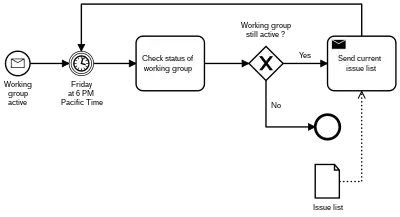
The business objective is often to increase process speed or reduce cycle time; to increase quality; or to reduce costs, such as labor, materials, scrap, or capital costs. In practice, a management decision to invest in business process modeling is often motivated by the need to document requirements for an information technology project.
Change management programs are typically involved to put any improved business processes into practice. With advances in software design, the vision of BPM models becoming fully executable (and capable of simulations and round-trip engineering) is coming closer to reality.
History
Techniques to model business process such as the flow chart, functional flow block diagram, control flow diagram, Gantt chart, PERT diagram, and IDEF have emerged since the beginning of the 20th century. The Gantt charts were among the first to arrive around 1899, the flow charts in the 1920s, Functional Flow Block Diagram and PERT in the 1950s, Data Flow Diagrams and IDEF in the 1970s. Among the modern methods are Unified Modeling Language and Business Process Model and Notation. Still, these represent just a fraction of the methodologies used over the years to document business processes.[1] The term 'business process modeling' was coined in the 1960s in the field of systems engineering by S. Williams in his 1967 article 'Business Process Modelling Improves Administrative Control'.[2] His idea was that techniques for obtaining a better understanding of physical control systems could be used in a similar way for business processes. It was not until the 1990s that the term became popular.
In the 1990s the term 'process' became a new productivity paradigm.[3] Companies were encouraged to think in processes instead of functions and procedures. Process thinking looks at the chain of events in the company from purchase to supply, from order retrieval to sales, etc. The traditional modeling tools were developed to illustrate time and cost, while modern tools focus on cross-functional activities. These cross-functional activities have increased significantly in number and importance, due to the growth of complexity and dependence. New methodologies include business process redesign, business process innovation, business process management, integrated business planning, among others, all "aiming at improving processes across the traditional functions that comprise a company".[3]
In the field of software engineering, the term 'business process modeling' opposed the common software process modeling, aiming to focus more on the state of the practice during software development.[4] In that time (the early 1990s) all existing and new modeling techniques to illustrate business processes were consolidated as 'business process modeling languages'. In the Object Oriented approach, it was considered to be an essential step in the specification of business application systems. Business process modeling became the base of new methodologies, for instance, those that supported data collection, data flow analysis, process flow diagrams, and reporting facilities. Around 1995, the first visually oriented tools for business process modeling and implementation were being presented.
Topics
Business model
A business model is a framework for creating economic, social, and/or other forms of value. The term 'business model' is thus used for a broad range of informal and formal descriptions to represent core aspects of a business, including purpose, offerings, strategies, infrastructure, organizational structures, trading practices, and operational processes and policies.
In the most basic sense, a business model is a method of doing business by which a company can sustain itself. That is, generate revenue. The business model spells-out how a company makes money by specifying where it is positioned in the value chain.
Business process
A business process is a collection of related, structured activities or tasks that produce a specific service or product (serve a particular goal) for a particular customer or customers. There are three main types of business processes:
- Management processes, that govern the operation of a system. Typical management processes include corporate governance and strategic management.
- Operational processes, that constitute the core business and create the primary value stream. Typical operational processes are purchasing, manufacturing, marketing, and sales.
- Supporting processes, that support the core processes. Examples include accounting, recruitment, and technical support.
A business process can be decomposed into several sub-processes, which have their own attributes but also contribute to achieving the goal of the super-process. The analysis of business processes typically includes the mapping of processes and sub-processes down to activity level. A business process model is a model of one or more business processes and defines the ways in which operations are carried out to accomplish the intended objectives of an organization. Such a model remains an abstraction and depends on the intended use of the model. It can describe the workflow or the integration between business processes. It can be constructed in multiple levels.
A workflow is a depiction of a sequence of operations, declared as work of a person, of a simple or complex mechanism, of a group of persons,[5] of an organization of staff, or of machines. The workflow may be seen as any abstraction of real work, segregated into workshare, work split or other types of ordering. For control purposes, the workflow may be a view of real work under a chosen aspect.
Artifact-centric business process
The artifact-centric business process model has emerged as a holistic approach for modeling business processes, as it provides a highly flexible solution to capture operational specifications of business processes. It particularly focuses on describing the data of business processes, known as "artifacts", by characterizing business-relevant data objects, their life-cycles, and related services. The artifact-centric process modelling approach fosters the automation of the business operations and supports the flexibility of the workflow enactment and evolution.[6]
Tools
Business process modelling tools provide business users with the ability to model their business processes, implement and execute those models, and refine the models based on as-executed data. As a result, business process modelling tools can provide transparency into business processes, as well as the centralization of corporate business process models and execution metrics.[7] Modelling tools may also enable collaborate modelling of complex processes by users working in teams, where users can share and simulate models collaboratively.[8] Business process modelling tools should not be confused with business process automation systems - both practices have modeling the process as the same initial step and the difference is that process automation gives you an ‘executable diagram’ and that is drastically different from traditional graphical business process modelling tools.
Modelling and simulation
Modelling and simulation functionality allows for pre-execution "what-if" modelling and simulation. Post-execution optimization is available based on the analysis of actual as-performed metrics.[7]
- Use case diagrams created by Ivar Jacobson, 1992 (integrated in UML)
- Activity diagrams (also adopted by UML)
Modelling techniques
Some business process modelling techniques are:
- Business Process Model and Notation (BPMN)
- Lifecycle Modeling Language (LML)
- Subject-oriented business process management (S-BPM)
- Cognition enhanced Natural language Information Analysis Method (CogNIAM)
- Extended Business Modelling Language (xBML)
- Event-driven process chain (EPC)
- ICAM DEFinition (IDEF0)
- Unified Modelling Language (UML), extensions for business process
- Formalized Administrative Notation (FAN)
- Harbarian process modeling (HPM)
Business Process Model and Notation (BPMN)
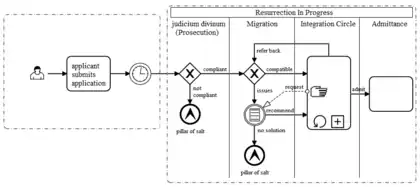
Business Process Model and Notation (BPMN) is a graphical representation for specifying business processes in a business process model.
Originally developed by the Business Process Management Initiative (BPMI), BPMN has been maintained by the Object Management Group (OMG) since the two organizations merged in 2005. Version 2.0 of BPMN was released in January 2011,[9] at which point the name was amended to Business Process Model and Notation to reflect the introduction of execution semantics, which were introduced alongside the existing notational and diagramming elements. Though it is an OMG specification, BPMN is also ratified as ISO 19510. The latest version is BPMN 2.0.2, published in January 2014.[10]Lifecycle Modeling Language (LML)
The Lifecycle Modeling Language (LML) is an open-standard modeling language designed for systems engineering. It supports the full lifecycle: conceptual, utilization, support and retirement stages. Along with the integration of all lifecycle disciplines including, program management, systems and design engineering, verification and validation, deployment and maintenance into one framework.[11] LML was originally designed by the LML steering committee. The specification was published October 17, 2013.
This is a modeling language like UML and SysML that supports additional project management uses such as risk analysis and scheduling. LML uses common language to define its modeling elements such as entity, attribute, schedule, cost, and relationship.[12]Subject-oriented business process management
Subject-oriented business process management (S-BPM) is a communication based view on actors (the subjects), which compose a business process orchestration or choreography.[13] The modeling paradigm uses five symbols to model any process and allows direct transformation into executable form.
Each business process consists of two or more subjects which exchange messages. Each subject has an internal behavior (capsulation), which is defined as a control flow between different states, which are receive and send message and do something. For practical usage and for syntactical sugaring there are more elements available, but not necessary.
In 2011 and 2012 S-BPM has been included in Gartner's Hype Cycle.Cognition enhanced Natural language Information Analysis Method
Cognition enhanced Natural language Information Analysis Method (CogNIAM) is a conceptual fact-based modelling method, that aims to integrate the different dimensions of knowledge: data, rules, processes and semantics. To represent these dimensions world standards SBVR, BPMN and DMN from the Object Management Group (OMG) are used. CogNIAM, a successor of NIAM, is based on the work of knowledge scientist Sjir Nijssen.
CogNIAM structures knowledge, gathered from people, documentation and software, by classifying it. For this purpose CogNIAM uses the so-called ‘Knowledge Triangle’.[14] The outcome of CogNIAM is independent of the person applying it. The resulting model allows the knowledge to be expressed in diagrammatic form as well as in controlled natural language.[15]Event-driven process chain (EPC)
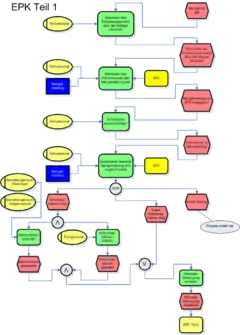
An event-driven process chain (EPC) is a type of flow chart for business process modeling. EPC can be used to configure enterprise resource planning execution, and for business process improvement. It can be used to control an autonomous workflow instance in work sharing.
The event-driven process chain method was developed within the framework of Architecture of Integrated Information Systems (ARIS) by August-Wilhelm Scheer at the Institut für Wirtschaftsinformatik, Universität des Saarlandes (Institute for Business Information Systems at the University of Saarland) in the early 1990s.[16]Integration Definition (IDEF)
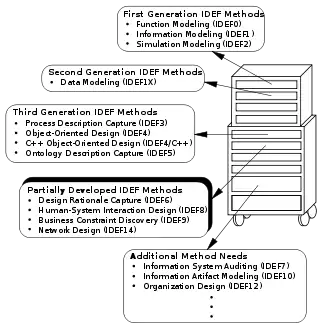
IDEF, initially an abbreviation of ICAM Definition and renamed in 1999 as Integration Definition,[18] is a family of modeling languages in the field of systems and software engineering. They cover a wide range of uses from functional modeling to data, simulation, object-oriented analysis and design, and knowledge acquisition. These definition languages were developed under funding from U.S. Air Force and, although still most commonly used by them and other military and United States Department of Defense (DoD) agencies, are in the public domain.
The most-widely recognized and used components of the IDEF family are IDEF0, a functional modeling language building on SADT, and IDEF1X, which addresses information models and database design issues.Unified Modelling Language (UML)
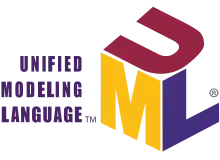
The unified modeling language (UML) is a general-purpose visual modeling language that is intended to provide a standard way to visualize the design of a system.[19]
UML provides a standard notation for many types of diagrams which can be roughly divided into 3 main groups: behavior diagrams, interaction diagrams, and structure diagrams.
The creation of UML was originally motivated by the desire to standardize the disparate notational systems and approaches to software design. It was developed at Rational Software in 1994–1995, with further development led by them through 1996.[19]
In 1997, UML was adopted as a standard by the Object Management Group (OMG), and has been managed by this organization ever since. In 2005, UML was also published by the International Organization for Standardization (ISO) and the International Electrotechnical Commission (IEC) as the ISO/IEC 19501 standard.[20] Since then the standard has been periodically revised to cover the latest revision of UML.[21]
In software engineering, most practitioners do not use UML, but instead produce informal hand drawn diagrams; these diagrams, however, often include elements from UML.[22]: 536Formalized Administrative Notation (FAN)
Harbarian process modeling (HPM)
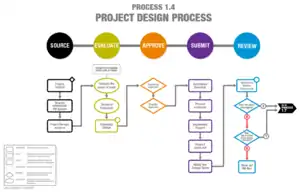
Harbarian process modeling (HPM) is a method for obtaining internal process information from an organization and then documenting that information in a visually effective, simple manner.
The HPM method involves two levels:
- Process diagrams: High-level overviews of specific processes or workflows.
- Systems diagrams: Mapping how each process is correlated, as well as various inputs, outputs, goals, feedback loops, and external factors.
Programming language tools
BPM suite software provides programming interfaces (web services, application program interfaces (APIs)) which allow enterprise applications to be built to leverage the BPM engine.[7] This component is often referenced as the engine of the BPM suite.
Programming languages that are being introduced for BPM include:[23]
- Business Process Execution Language (BPEL),
- Web Services Choreography Description Language (WS-CDL).
- XML Process Definition Language (XPDL),
Some vendor-specific languages:
- Architecture of Integrated Information Systems (ARIS) supports EPC,
- Java Process Definition Language (JBPM),
Other technologies related to business process modelling include model-driven architecture and service-oriented architecture.
Related concepts
Business reference model
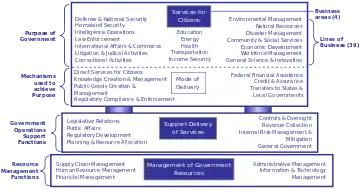
A business reference model is a reference model, concentrating on the functional and organizational aspects of an enterprise, service organization or government agency. In general a reference model is a model of something that embodies the basic goal or idea of something and can then be looked at as a reference for various purposes. A business reference model is a means to describe the business operations of an organization, independent of the organizational structure that perform them. Other types of business reference model can also depict the relationship between the business processes, business functions, and the business area's business reference model. These reference models can be constructed in layers, and offer a foundation for the analysis of service components, technology, data, and performance.
The most familiar business reference model is the Business Reference Model of the US federal government. That model is a function-driven framework for describing the business operations of the federal government independent of the agencies that perform them. The Business Reference Model provides an organized, hierarchical construct for describing the day-to-day business operations of the federal government. While many models exist for describing organizations – organizational charts, location maps, etc. – this model presents the business using a functionally driven approach.[25]
Business process integration
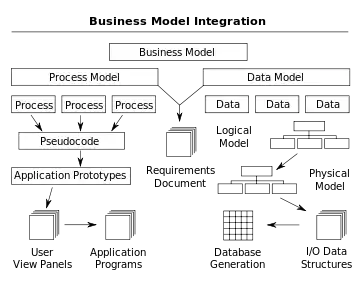
A business model, which may be considered an elaboration of a business process model, typically shows business data and business organizations as well as business processes. By showing business processes and their information flows, a business model allows business stakeholders to define, understand, and validate their business enterprise. The data model part of the business model shows how business information is stored, which is useful for developing software code. See the figure on the right for an example of the interaction between business process models and data models.[26]
Usually a business model is created after conducting an interview, which is part of the business analysis process. The interview consists of a facilitator asking a series of questions to extract information about the subject business process. The interviewer is referred to as a facilitator to emphasize that it is the participants, not the facilitator, who provide the business process information. Although the facilitator should have some knowledge of the subject business process, but this is not as important as the mastery of a pragmatic and rigorous method interviewing business experts. The method is important because for most enterprises a team of facilitators is needed to collect information across the enterprise, and the findings of all the interviewers must be compiled and integrated once completed.[26]
Business models are developed as defining either the current state of the process, in which case the final product is called the "as is" snapshot model, or a concept of what the process should become, resulting in a "to be" model. By comparing and contrasting "as is" and "to be" models the business analysts can determine if the existing business processes and information systems are sound and only need minor modifications, or if reengineering is required to correct problems or improve efficiency. Consequently, business process modeling and subsequent analysis can be used to fundamentally reshape the way an enterprise conducts its operations.[26]
Business process re-engineering
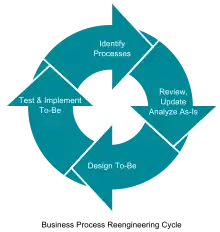
Business process reengineering (BPR) aims to improve the efficiency and effectiveness of the processes that exist within and across organizations. It examines business processes from a "clean slate" perspective to determine how best to construct them.
Business process re-engineering (BPR) began as a private sector technique to help organizations fundamentally rethink how they do their work. A key stimulus for re-engineering has been the development and deployment of sophisticated information systems and networks. Leading organizations use this technology to support innovative business processes, rather than refining current ways of doing work.[27]
Business process management
Business process management (BPM) is the discipline in which people use various methods to discover, model, analyze, measure, improve, optimize, and automate business processes.[28][29] Any combination of methods used to manage a company's business processes is BPM.[30] Processes can be structured and repeatable or unstructured and variable. Though not required, enabling technologies are often used with BPM.[28]
As an approach, BPM sees processes as important assets of an organization that must be understood, managed, and developed to announce and deliver value-added products and services to clients or customers. This approach closely resembles other total quality management or continual improvement process methodologies.
ISO 9000 promotes the process approach to managing an organization.
...promotes the adoption of a process approach when developing, implementing and improving the effectiveness of a quality management system, to enhance customer satisfaction by meeting customer requirements.[31]
BPM proponents also claim that this approach can be supported, or enabled, through technology.[32] As such, many BPM articles and scholars frequently discuss BPM from one of two viewpoints: people and/or technology.
BPM streamlines business processing by automating workflows; while RPA automates tasks by recording a set of repetitive activities implemented by human. Organizations maximize their business automation leveraging both technologies to achieve better results.See also
- Artifact-centric business process model
- Business architecture
- Business Model Canvas
- Business plan
- Business process mapping
- Business Process Model and Notation
- Capability Maturity Model Integration
- Drakon-chart
- Generalised Enterprise Reference Architecture and Methodology
- Model Driven Engineering
- Outline of consulting
- PinpointBPS
- Value Stream Mapping
References
- Thomas Dufresne & James Martin (2003). "Process Modeling for E-Business". INFS 770 Methods for Information Systems Engineering: Knowledge Management and E-Business. Spring 2003
- Williams, S. (1967) "Business Process Modeling Improves Administrative Control," In: Automation. December, 1967, pp. 44 - 50.
- Asbjørn Rolstadås (1995). "Business process modeling and re-engineering". in: Performance Management: A Business Process Benchmarking Approach. p. 148-150.
- Brian C. Warboys (1994). Software Process Technology: Third European Workshop EWSPT'94, Villard de Lans, France, February 7–9, 1994: Proceedings. p. 252.
- See e.g., ISO 12052:2006
- Yongchareon, Sira (2015). "A View Framework for Modelling and Change Validation of Artifact-Centric Inter-Organizational Business Processes". Information Systems. 47: 51–81. doi:10.1016/j.is.2014.07.004.
- Workflow/Business Process Management (BPM) Service Pattern Archived 2009-01-13 at the Wayback Machine June 27, 2007. Accessed 29 nov 2008.
- Christensen, Lars Rune & Thomas Hildebrandt (2017) Modelling Cooperative Work at a Medical Department. Proceedings of the 8th International Conference on Communities and Technologies. Troyes, France. ACM.
- OMG. "BPMN 2.0". Retrieved 2011-03-29.
- "About the Business Process Model and Notation Specification Version 2.0.2". www.omg.org. Retrieved 2020-12-07.
- LML Steering Committee. "LML Specification". Retrieved 2023-03-01.
- "About Lifecycle Modeling Language". LML Steering Committee. Retrieved 2014-06-05.
- Fleischmann, Albert; Stary, Christian (2011). "Whom to talk to? A stakeholder perspective on business process development". Universal Access in the Information Society. 11 (2): 1–28. doi:10.1007/s10209-011-0236-x.
- Sjir Nijssen and André Le Cat. Kennis Gebaseerd Werken], 2009. p. 118-148
- Nijssen, Gerardus Maria, and Terence Aidan Halpin. Conceptual Schema and Relational Database Design: a fact oriented approach. Prentice-Hall, Inc., 1989.
- <trans oldtip="A.-W. Scheer (2002). " newtip="A.-W.Scheer(2002年)。">A.-W.Scheer(2002年)。</trans><trans oldtip="ARIS. Vom Geschäftsprozess zum Anwendungssystem" newtip="阿里斯。vm Gesch ftsprozess zum Anwendungssystem">阿里斯。vm Gesch ftsprozess zum Anwendungssystem</trans>. Springer. p.20.
- Richard J. Mayer (1995) et al. Information Integration for Concurrent Engineering (IICE) Compendium of methods report. Wright-Patterson Air Force Base, Ohio 45433-7604.
- IEEE Standard for Functional Modeling Language—Syntax and Semantics for IDEF0, Software Engineering Standards Committee of the IEEE Computer Society, IEEE-SA Standards Board, The Institute of Electrical and Electronics Engineers, Inc. 345 East 47th Street, New York, NY 10017-2394, USA, IEEE Std 1320.1-1998, 25 June 1998
- Unified Modeling Language User Guide, The (2 ed.). Addison-Wesley. 2005. p. 496. ISBN 0321267974. , See the sample content, look for history
- "ISO/IEC 19501:2005 - Information technology - Open Distributed Processing - Unified Modeling Language (UML) Version 1.4.3". Iso.org. 2005-04-01. Retrieved 2015-05-07.
- "ISO/IEC 19505-1:2012 - Information technology - Object Management Group Unified Modeling Language (OMG UML) - Part 1: Infrastructure". Iso.org. 2012-04-20. Retrieved 2014-04-10.
- Baltes, Sebastian; Diehl, Stephan (2014-11-11). "Sketches and diagrams in practice". Proceedings of the 22nd ACM SIGSOFT International Symposium on Foundations of Software Engineering. FSE 2014. Hong Kong, China: Association for Computing Machinery. pp. 530–541. arXiv:1706.09172. doi:10.1145/2635868.2635891. ISBN 978-1-4503-3056-5. S2CID 2436333.
- "Business Process Modelling FAQ". Archived from the original on 2008-11-09. Retrieved 2008-11-02.
- FEA (2005) FEA Records Management Profile, Version 1.0. December 15, 2005.
- FEA Consolidated Reference Model Document Archived 2010-10-11 at the Wayback Machine. Oct 2007.
- Paul R. Smith & Richard Sarfaty (1993). Creating a strategic plan for configuration management using Computer Aided Software Engineering (CASE) tools. Paper For 1993 National DOE/Contractors and Facilities CAD/CAE User's Group.
- Business Process Reengineering Assessment Guide Archived 2017-02-18 at the Wayback Machine, United States General Accounting Office, May 1997.
- Jeston, John; Nelis, Johan (2014-01-21). Business Process Management. Routledge. ISBN 9781136172984.
- Theodore Panagacos (25 September 2012). The Ultimate Guide to Business Process Management: Everything You Need to Know and How to Apply It to Your Organization. CreateSpace Independent Publishing Platform. pp. 6–7. ISBN 978-1-4774-8613-9.
- Palmer, Nathaniel. "What Is BPM". bpm.com. Retrieved 2017-09-30.
- Source: clause 0.2 of ISO 9001:2000
- Managing Performance Through Business Processes, Dominique Thiault, ISBN 978-1-4680-2890-4
Further reading
- Aguilar-Saven, Ruth Sara. "Business process modelling: Review and framework." International Journal of production economics 90.2 (2004): 129–149.
- Barjis, Joseph (2008). "The importance of business process modeling in software systems design". Science of Computer Programming. 71: 73–87. doi:10.1016/j.scico.2008.01.002.
- Becker, Jörg, Michael Rosemann, and Christoph von Uthmann. "Guidelines of business process modelling." Business Process Management. Springer Berlin Heidelberg, 2000. 30–49.
- Hommes, L.J. The Evaluation of Business Process Modelling Techniques. Doctoral thesis. Technische Universiteit Delft.
- Håvard D. Jørgensen (2004). Interactive Process Models{{|bot=InternetArchiveBot |fix-attempted=yes }}. Thesis Norwegian University of Science and Technology Trondheim, Norway.
- Manuel Laguna, Johan Marklund (2004). Business Process Modeling, Simulation, and Design. Pearson/Prentice Hall, 2004.
- Ovidiu S. Noran (2000). Business Modelling: UML vs. IDEF Paper Griffh University
- Jan Recker (2005). "Process Modelling in the 21st Century". In: BP Trends, May 2005.
- Ryan K. L. Ko, Stephen S. G. Lee, Eng Wah Lee (2009) Business Process Management (BPM) Standards: A Survey. In: Business Process Management Journal, Emerald Group Publishing Limited. Volume 15 Issue 5. ISSN 1463-7154.
- Jan Vanthienen, S. Goedertier and R. Haesen (2007). "EM-BrA2CE v0.1: A vocabulary and execution model for declarative business process modelling". DTEW - KBI_0728.
External links
 Media related to Business process modeling at Wikimedia Commons
Media related to Business process modeling at Wikimedia Commons